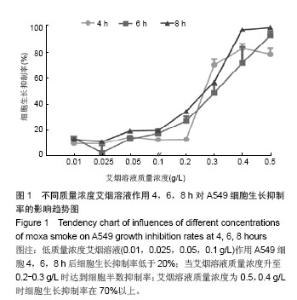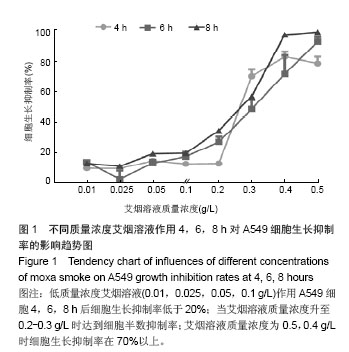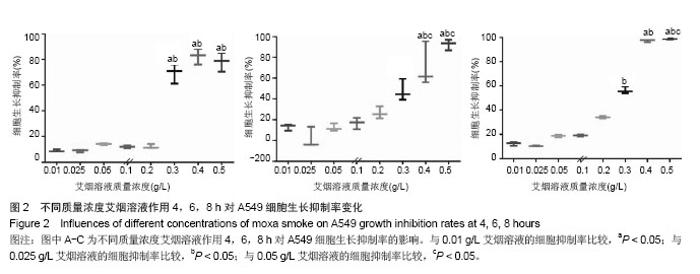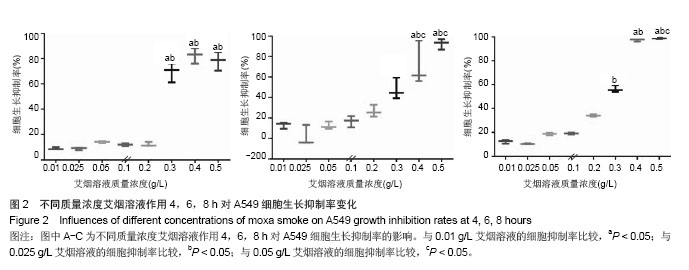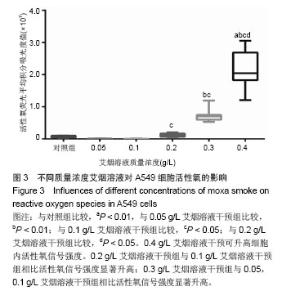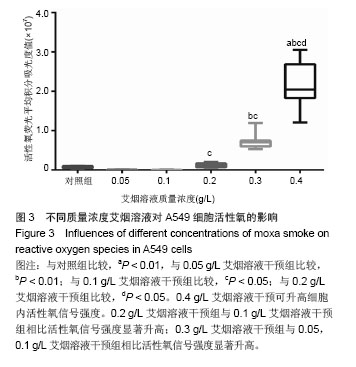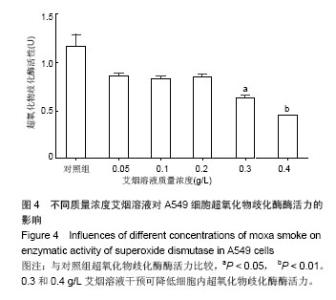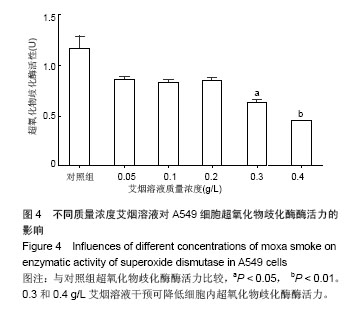| [1]吴焕淦,马晓芃,周次利,等.灸法研究现状与战略思考[J].世界中医药,2013,8(8):845-851.
[2]Zhou CL, Feng XM, Wang JH, et al. Research advance on moxa smoke. J Acupunct Tuina Sci. 2011;9(2):67-72.
[3]兰蕾,张国山,石佳,等.艾烟的应用和不良反应研究进展[J].中华中医药学刊,2012,30(1):48-51.
[4]金复生,顾正华,朱瑞娟.艾条燃烧烟雾抽提物的致突变性研究[J].癌变•畸变•突变,1995,7(5):281.
[5]周次利,吴璐一,窦传字,等.艾灸生成物对大鼠脑神经系统形态学的影响[J].上海针灸杂志,2014,33(6):495-498.
[6]兰蕾,常小荣,谭静,等.艾烟的急性毒理试验[J].光明中医, 2011, 26(10):1992-1995.
[7]兰蕾,常小荣,张国山,等.艾烟对大鼠病理组织切片和肺HSP70及Caspase-9表达的影响[J].中华中医药杂志, 2012,27(4): 1042-1047.
[8]胡海,赵百孝,邬继红,等.艾烟冷凝物对肺泡Ⅱ型上皮细胞 A549活性及凋亡的影响[J].北京中医药大学学报,2012,35(6): 426-429.
[9]胡海,赵百孝,邬继红,等.艾烟冷凝物对肺泡Ⅱ型上皮细胞A549形态及活性的影响[J].北京中医药大学学报(中医临床版),2012, 19(6):13-15.
[10]韩丽,刘平,胡海,等.艾烟中可吸入颗粒诱发染色体畸变效应的实验研究[J].中国中医药信息杂志,2013,20(1):34-36.
[11]黄玉海,刘平,杨必成,等.艾烟可吸入颗粒物对人肺腺癌A549细胞凋亡的影响[J].中国中医药信息杂志,2014,21(7):53-57.
[12]窦传字,吴焕淦,洪宗国,等.不同储存年份的艾条燃烧生成自由基的ESR波谱研究[J].世界中医药,2013,8(8):852-855.
[13]易健,舒徐.活性氧对细胞凋亡和增殖的调控作用[J].基础医学与临床,2013,33(10):1127-1130.
[14]胡平,吴耿伟,夏青,等.SOD模拟及其抗氧化和抗炎症功能的研究进展[J].化学进展,2009,21(5):873-879.
[15]郁军超,薛连璧.机体ROS的产生及对生物大分子的毒性作用[J].山东医药,2012,52(8):94-96,102.
[16]Nauseef WM. Nox enzymes in immune cells. SeminImmunopathol. 2008;30(3):195-208.
[17]Thannickal VJ, Fanburg BL. Reactive oxygen species in cell signaling. Am J Physiol Lung Cell MolPhysiol. 2000;279(6): L1005-L1028.
[18]Allen RG, Tresini M. Oxidative stress and gene regulation. Free Radic Biol Med. 2000;28(3):463-499.
[19]Valko M, Leibfritz D, Moncol J, et al. Free radicals and antioxidants in normal physiological functions and human disease. Int J Biochem Cell Biol. 2007,39(1):44-84.
[20]赵云罡,徐建兴.线粒体,活性氧和细胞凋亡[J].生物化学与生物物理进展,2001,28(2):168-171.
[21]许焕芳,崔莹雪,黄茶熙,等.艾燃烧生成物对快速老化模型小鼠SAMP8血清抗氧化酶的影响[J].中国针灸,2012,32(1):53-57.
[22]孟笑男,徐焕芳,崔莹雪,等.艾燃烧生成物对快速老化模型小鼠大脑SOD、MDA和GSH-Px的影响[J].环球中医药,2011,4(6): 413-415.
[23]沈继龙,朱克军,顾红军,等.大鼠心肌缺血再灌注损伤不同时相氧化应激相关指标的变化[J].临床和实验医学杂志,2013,12(3): 177-178.
[24]曾昭惠,杜琼.自由基氧化致线粒体DNA损伤与细胞凋亡[J].国外医学:临床生物化学与检验学分册,1999,20(4):167-168.
[25]van der Toorn M, Slebos DJ, de Bruin HG, et al. Cigarette smoke-induced blockade of the mitochondrial respiratory chain switches lung epithelial cell apoptosis into necrosis. Am J Physiol Lung Cell Mol Physiol. 2007;292:L1211-L1218.
[26]李强,蒋伯诚,马春华,等.关于艾灸烟雾化学成分的实验分析[J].黑龙江中医药,1993,16(4):44-46.
[27]靳然,赵百孝,于密密,等.艾燃烧生成物组分固相微萃取气相色谱质谱法定性分析[J].北京中医药大学学报,2011,34(9):632-636.
[28]洪宗国,农熠瑛,江丹,等.艾叶燃烧产物化学成分的分析[J].中国针灸,2009,29(增刊):60-62.
[29]杨梅,江丹,易筠,等.艾叶燃烧物清除自由基作用的观察[J].中国针灸,2009,29(7):547-549.
[30]王金海,赵天平,吴焕淦,等.艾烟临床安全性评价的思考[J].上海针灸杂志,2010,29(1):6-8. |
